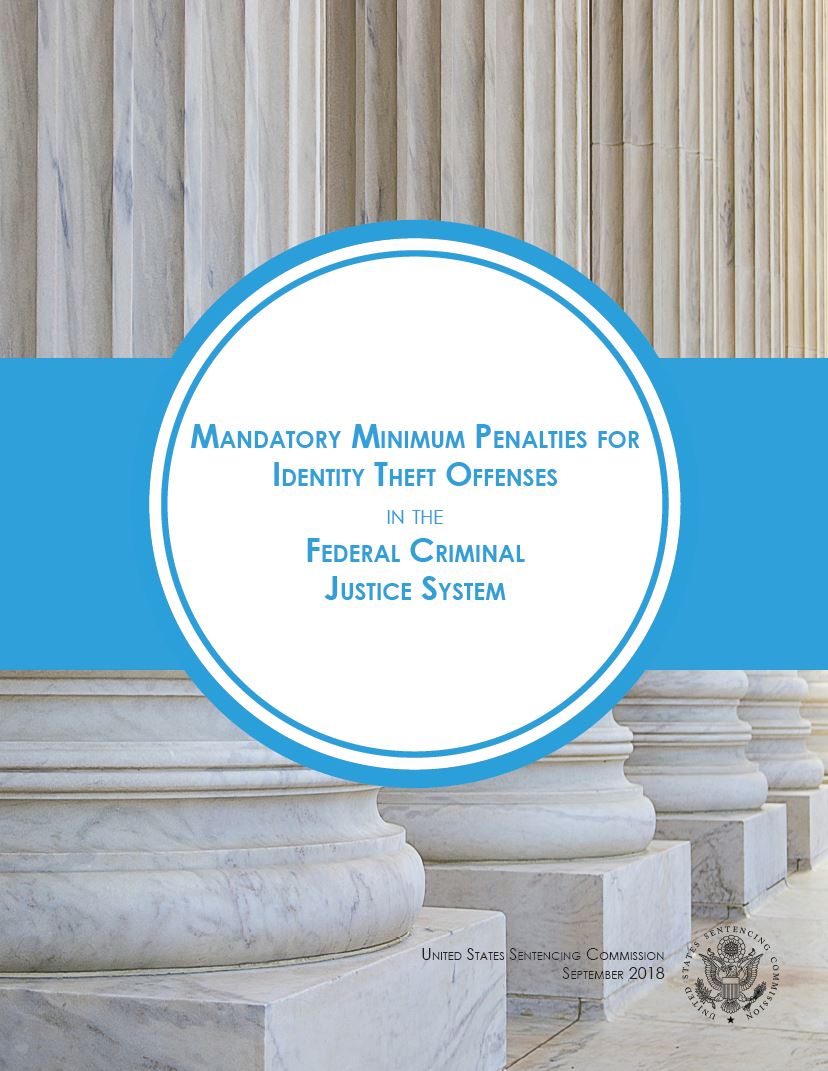Summary

Using fiscal year 2016 data, this publication includes analyses of 18 U.S.C. § 1028A, which provides for a two-year mandatory minimum penalty, as compared to identity theft offenses that do not carry mandatory minimum penalties, as well as the impact of these offenses on the Federal Bureau of Prisons (BOP) population. Where appropriate, the publication highlights changes and trends since the Commission’s 2011 Mandatory Minimum Report.
Other Related Materials:
- Quick Facts on Aggravated Identity Theft Offenses (FY17 data)
- Quick Facts on Mandatory Minimum Penalties (FY17 data)
- Related Reports:
Key Findings
-
Mandatory minimum penalties for identity theft offenses are applied less often in the federal system compared to other mandatory minimum penalties.
- Offenders convicted under section 1028A comprised only 1.6 percent (n=978) of federal offenders sentenced in fiscal year 2016.
- Section 1028A offenses accounted for 7.2 percent of offenses carrying a mandatory minimum penalty in fiscal year 2016.
-
However, the use of section 1028A mandatory minimum penalties against identity theft offenders has become more prevalent.
- Of the cases involving identity theft offenses, slightly more than half (53.4%) were convicted under section 1028A, while 46.6 percent were convicted of an identity theft offense that did not carry a mandatory minimum penalty.
- The percentage of identity theft offenders convicted under section 1028A has steadily increased, more than doubling from 21.9 percent in fiscal year 2006 to 53.4 percent in fiscal year 2016. This percentage is more than ten percentage points higher than reported in the Commissions 2011 Mandatory Minimum Report, when it was 42.6 percent.
- Section 1028A aggravated identity theft offenses also increased as a portion of all offenses carrying a mandatory minimum penalty, from 4.0 percent in fiscal year 2010 to 7.2 percent in fiscal year 2016.
-
Sentences imposed pursuant to section 1028A are longer than sentences imposed for identity theft offenses not carrying a mandatory minimum penalty.
- In fiscal year 2016, the average sentence length for offenders convicted of at least one count under section 1028A was more than double the average sentence length for offenders convicted of an identity theft offense not carrying a mandatory minimum penalty (51 months compared to 22 months).
- Identity theft offenders convicted of at least one count under section 1028A had a longer average sentence than offenders convicted of an identity theft offense not carrying a mandatory minimum penalty even if they received relief from the mandatory minimum penalty length (32 months compared to 22 months).
-
In addition, other charging and plea decisions also play a role in the application and impact of identity theft mandatory minimum penalties.
- The majority of section 1028A offenders (88.7%) were also convicted of at least one other felony offense, which is consistent with the statutory requirement that an offender must have “knowingly transferred, possessed, or used a means of identification of another person during and in relation to any enumerated felony violation.”
- Conversely, 11.3 percent were convicted of an offense under section 1028A alone, although those cases necessarily involved another federal offense for which they were not charged and convicted.
- The average sentence for offenders who were convicted under section 1028A and another statute was more than double the average sentence for offenders convicted only under section 1028A (54 months compared to 22 months).
-
A small percentage of section 1028A offenders are convicted of multiple counts under the statute. When they are, courts frequently exercise their discretion to impose concurrent sentences, in whole or in part, for additional counts under the statute.
- In fiscal year 2016, 89.2 percent (n=872) of offenders convicted under section 1028A were convicted of a single count, and 10.8 percent (n=106) were convicted of multiple counts under the statute.
- For those offenders convicted of multiple counts under section 1028A, the court exercised its discretion to impose sentences for additional 1028A counts concurrently in the overwhelming majority of cases (89.6%).
- Even though courts limit the impact of convictions for multiple counts under section 1028A by imposing concurrent sentences, offenders convicted of multiple counts under section 1028A still had a longer average sentence than offenders convicted of a single count under the statute (74 months compared to 48 months). The longer sentence length was due to the fact that such offenders were also more likely to have been convicted of another offense (for which section 1028A requires a consecutively-imposed sentence) than offenders convicted of a single 1028A count.
-
The section 1028A mandatory minimum penalty impacts Black offenders more than any other racial group.
- Black offenders were convicted under section 1028A at a higher rate than any other racial group. In fiscal year 2016, Black offenders represented 49.8 percent of all identity theft offenders, yet accounted for 58.7 percent of offenders convicted under section 1028A.
- Black offenders’ proportion of those convicted under section 1028A in fiscal year 2016 (58.7%) represented a substantial increase from fiscal year 2010, when they represented 40.2 percent of such offenders. Conversely, White offenders became a smaller proportion of identity theft offenders convicted under section 1028A, having fallen by nearly half (from 32.8% in fiscal year 2010 to 18.7% in fiscal year 2016).
- Black offenders were also convicted under section 1028A at the highest rate when considering identity theft offenders within each racial group. In fiscal year 2016, a majority (63.1%) of Black identity theft offenders were convicted under section 1028A, which was higher than the rate for White offenders (47.8%), Other Race offenders (42.0%), and Hispanic offenders (41.1%).
- Black offenders were also most likely to be convicted of multiple counts under section 1028A, comprising 58.5 percent of such offenders, followed by White offenders (25.5%), Hispanic offenders (13.2%), and Other Race offenders (2.8%).
